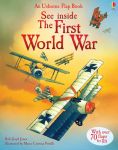You've added:
See Inside The First World WarSee Inside The First World War
Age 6+
Buy from:
With vivid illustrations and over 70 flaps to lift, this action-packed book transports readers into the battlefields of the First World War, from the muddy trenches of northern France to the jungles of East Africa. Packed with essential information about the First World War, from the start of the conflict in 1914 to its resolution in 1918. Look inside trenches, see an attack across no man's land, find out what goes on inside a tank, how fighter planes defended the skies against airships and lots more. Written in conjunction with a historical consultant from the Imperial War Museums.
Chapters in this book include:
- Outbreak
- Digging in
- Over the top
- Warships
- In the skies
- The War Spreads
- To the end
- Final shots
- Extent:
- 16 pages
- Dimensions:
- 282.9 x 214.6mm
- Board ISBN:
- 9781409531708
- Key Stage:
- KS1, KS2
- Publication Date:
- June 2013
- Work Reference:
- 00670
Chapters in this book include:
- Outbreak
- Digging in
- Over the top
- Warships
- In the skies
- The War Spreads
- To the end
- Final shots
View series: See Inside
As a first introduction for younger readers, Rob Lloyd Jones's See inside the First World War presents the information in small-sized bites and with the help of flaps.
Written specially for KS2 children, the See inside...series offers flaps to lift, vivid illustrations and fascinating facts to uncover.
Quicklinks
Visit Usborne Quicklinks for links to websites where you can experience a dog fight with ace pilots in WW1 planes and find out about the life of a soldier in the trenches or a sailor at sea.


